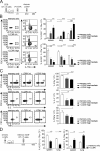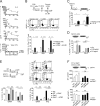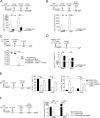Chronic virus infection compromises memory bystander T cell function in an IL-6/STAT1-dependent manner
- PMID: 30745322
- PMCID: PMC6400541
- DOI: 10.1084/jem.20181589
Chronic virus infection compromises memory bystander T cell function in an IL-6/STAT1-dependent manner
Abstract
Chronic viral infections are widespread among humans, with ∼8-12 chronic viral infections per individual, and there is epidemiological proof that these impair heterologous immunity. We studied the impact of chronic LCMV infection on the phenotype and function of memory bystander CD8+ T cells. Active chronic LCMV infection had a profound effect on total numbers, phenotype, and function of memory bystander T cells in mice. The phenotypic changes included up-regulation of markers commonly associated with effector and exhausted cells and were induced by IL-6 in a STAT1-dependent manner in the context of chronic virus infection. Furthermore, bystander CD8 T cell functions were reduced with respect to their ability to produce inflammatory cytokines and to undergo secondary expansion upon cognate antigen challenge with major cell-extrinsic contributions responsible for the diminished memory potential of bystander CD8+ T cells. These findings open new perspectives for immunity and vaccination during chronic viral infections.
© 2019 Barnstorf et al.
Figures








Comment in
-
Stand by me(mory): Chronic infection diminishes memory pool via IL-6/STAT1.J Exp Med. 2019 Mar 4;216(3):474-475. doi: 10.1084/jem.20190066. Epub 2019 Feb 19. J Exp Med. 2019. PMID: 30782615 Free PMC article.
References
Publication types
MeSH terms
Substances
LinkOut - more resources
Full Text Sources
Molecular Biology Databases
Research Materials
Miscellaneous

